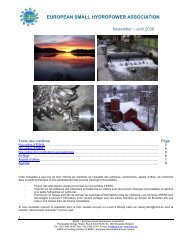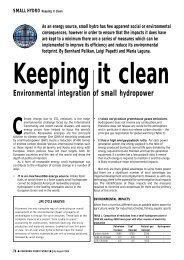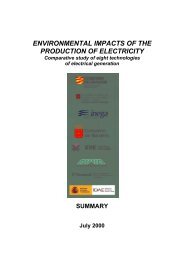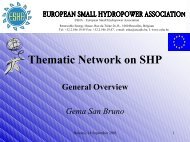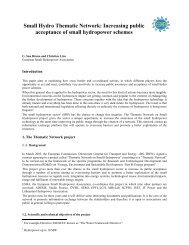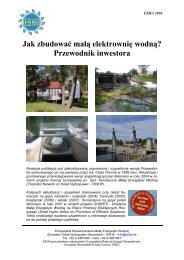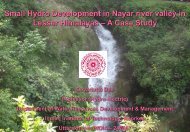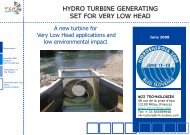HYDROPOWER AND ENVIRONMENT - ESHA
HYDROPOWER AND ENVIRONMENT - ESHA
HYDROPOWER AND ENVIRONMENT - ESHA
Create successful ePaper yourself
Turn your PDF publications into a flip-book with our unique Google optimized e-Paper software.
REPORT ON TECHNICAL <strong>AND</strong> OPERATIONAL PROCEDURE TO BETTER INTEGRATE SMALL HYDRO PLANTS IN THE <strong>ENVIRONMENT</strong><br />
2.2<br />
AESTHETICAL IMPROVEMENT<br />
HARMONY<br />
Each component of an hydro scheme - powerhouse,<br />
weir, spillway, penstock, intake, tailrace, substation<br />
and transmission line - has the potential to create a<br />
change in the visual impact of the site which is important<br />
to the public, who is increasingly reluctant to accept<br />
any changes to their visual environment. Most of<br />
these components may be screened from view on the<br />
base of a well-chosen design, i.e. by incorporating<br />
mitigation strategies that, usually, can facilitate permit<br />
issue without generating too many extra costs.<br />
2.2.1<br />
Powerhouse<br />
Especially in mountainous areas, the designer has to<br />
integrate the powerhouse in the environment to the<br />
best of her/his abilities. In order to minimize visual<br />
impacts, the most effective powerhouse is the interred<br />
one, but its cost can make a SHP investment unprofi -<br />
table. A good but cheaper solution is the use of natural<br />
features - local stones, ground, vegetation - to<br />
shroud the building and, if not applicable, painting it<br />
with non-contrasting colours and textures to reduce<br />
contrast with the background. It is very important to<br />
include specifi c elements that ensure the recognition<br />
of a SHP identity, allowing people to associate the<br />
concepts of beauty and peculiarity with these buildings,<br />
just as mills throughout the centuries had been<br />
conceived. In this way, aesthetics could become an<br />
opportunity to make the community aware of the<br />
highly positive value of such a plant.<br />
2.2.2<br />
Penstocks<br />
The penstock is usually the main cause of visual intrusion<br />
of a SHP, and it also forms a barrier to the movement<br />
of wild-life. From this point of view, an excellent<br />
solution is penstock interment, although this carries<br />
disadvantages in terms of control and geological<br />
risks connected with the stability of steep slopes.<br />
13<br />
Nowadays, the pipe and coatings have strongly improved<br />
at the technological level, to ensure that an<br />
interred penstock requires practically no maintenance<br />
for several decades. In particular, the choice of glass<br />
reinforced plastic pipes is strategic to control corrosion<br />
and consequently reduces maintenance. Where<br />
a penstock cannot be interred, other mitigation measures<br />
available are the adoption of anchoring blocks<br />
and the elimination of expansion joints.<br />
2.3<br />
NOISE REDUCTION<br />
Noises and vibrations within a small hydroelectric<br />
plant come from the trash rack cleaner, the trash<br />
conveyor, the generator, the gearbox, the turbine,<br />
the transformer, the hydroelectric unit and the speed<br />
increaser. This sort of impact can be unacceptable<br />
when houses are located near to the powerhouse or<br />
when the plant is located in a protected natural site. In<br />
these cases, a careful design can allow the achievement<br />
of excellent levels of noise reduction and thus<br />
strongly mitigate the acoustic impact of the plant.<br />
Some of the most diffuse techniques are the following:<br />
small tolerances in gear manufacturing;<br />
sound insulating blankets over the turbine<br />
casing;<br />
water cooling instead of air cooling of the<br />
generator;<br />
acoustic insulation of the building.



